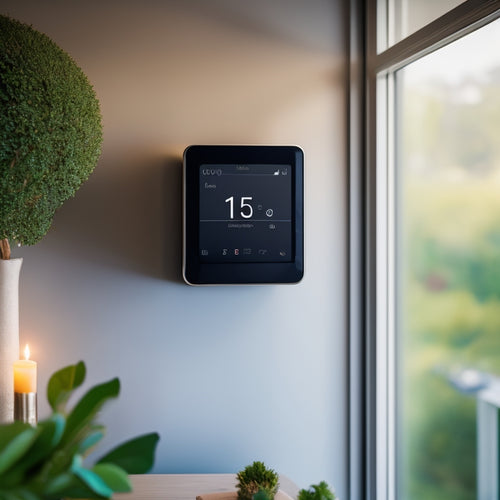
DIY Guide: Automate Your Home for Energy Savings
Share
By automating your home, you can optimize energy efficiency and reduce consumption. Focus on areas like lighting, temperature, and appliance control using smart home sensors, energy consumption analytics, and energy storage systems. Consider integrating renewable energy sources like solar panels, wind turbines, or geothermal systems to reduce your carbon footprint. Smart thermostats, automated lighting systems, and advanced appliance energy management can also help you save energy. Plus, water conservation automation systems can minimize waste and reduce bills. By implementing these DIY automation solutions, you can cut energy costs and make a positive impact on the environment - and that's just the beginning of your energy-saving expedition.
Key Takeaways
- Implement smart home sensors to optimize lighting levels and reduce energy consumption through automated adjustments.
- Invest in energy storage systems to alleviate peak grid demand and reduce reliance on non-renewable energy sources.
- Utilize energy consumption analytics to inform usage decisions and identify areas for improvement in your home.
- Install high-efficiency solar panels or renewable energy sources to generate clean energy and offset energy bills.
- Automate temperature control with smart thermostats and schedule lighting to prevent unnecessary usage and reduce energy waste.
Energy-Efficient Home Automation Tools
Three key areas to focus on when selecting energy-efficient home automation tools are lighting, temperature, and appliance control. You'll want to identify areas where you can optimize energy consumption.
Integrating renewable energy sources, such as solar power integration, can greatly reduce your carbon footprint. Additionally, utilizing energy storage systems can help reduce peak demand on the grid, enhancing energy efficiency.
Smart home sensors can help you monitor and adjust lighting levels, ensuring you're not wasting energy on unnecessary illumination. For temperature control, consider a smart thermostat that learns your schedule and preferences to optimize heating and cooling.
Appliance control allows you to monitor and schedule energy-intensive devices, like washing machines and dryers. Energy consumption analytics will provide useful perspectives into your energy usage, helping you make informed decisions about where to cut back.
Home Energy Generation Monitoring Apps
Your smart home's energy efficiency depends on your ability to monitor and manage the energy it generates. To do this, you'll need to employ home energy generation monitoring apps.
These apps connect to your solar panel system, providing real-time data on energy production and consumption. With energy usage tracking, you can identify areas of inefficiency and optimize your energy generation.
By leveraging high-efficiency solar panels with conversion rates up to 23% advanced charging algorithms, you can maximize your energy yield and reduce your reliance on the grid.
Solar panel apps like Sense, Neurio, and Tesla's Energy App offer detailed analytics, allowing you to monitor your energy production, usage, and savings.
Smart Thermostats for Temperature Control
You'll find that smart thermostats can optimize your home's temperature with energy efficiency modes that learn your schedule and preferences.
By incorporating solar panels and high-efficiency inverters renewable energy solutions, you can further reduce your energy consumption.
With smart scheduling features, you can program your thermostat to adjust the temperature when you're away or sleeping, reducing energy waste.
Additionally, you'll have remote temperature access, allowing you to adjust the temperature from your phone or tablet, even when you're not at home.
Energy Efficiency Modes
Automating temperature control in your home is an essential step towards energy efficiency, and smart thermostats are the perfect solution. You can program them to optimize your energy consumption by setting energy efficiency modes.
These modes allow you to create customized temperature settings that align with your energy saving habits. For instance, you can set your thermostat to "Eco" mode when you're away from home or sleeping, which can help reduce energy waste.
Additionally, you can receive automated notifications to adjust your temperature settings when you're not at home, ensuring that you're not heating or cooling an empty space.
By integrating renewable energy sources, such as solar-powered fast charging, into your home's energy grid, you can further minimize your carbon footprint. This can be achieved by investing in sustainable charging solutions, which not only reduce energy waste but also promote eco-friendly practices.
Smart Scheduling Features
Smart thermostats take temperature control to the next level with their advanced smart scheduling features. These features allow you to create personalized temperature settings that align with your daily routine, ensuring energy efficiency and comfort. With smart routines, you can set specific temperature schedules for different times of the day, such as when you're sleeping or away from home.
| Feature | Description | Benefit |
|---|---|---|
| Smart Routines | Create custom temperature schedules | Energy savings and comfort |
| Seasonal Adjustments | Adjust temperature settings for different seasons | Ideal temperature for each season |
| Geofencing | Automatically adjust temperature based on your location | Energy savings when you're away |
| Smart Learning | Thermostat learns your schedule and preferences | Automated temperature control |
| Energy Reports | Receive energy usage reports | Identify areas for improvement |
Remote Temperature Access
The ability to control your home's temperature remotely is a key benefit of smart thermostats, allowing you to adjust the temperature from anywhere, at any time, using your smartphone or tablet.
This feature is especially useful when you're away from home and want to make certain your home is at a comfortable temperature when you return. With remote temperature access, you can also receive temperature alerts if your home's temperature drops or rises beyond a set range, giving you peace of mind.
Many smart thermostats also come equipped with remote sensors, which can detect temperature fluctuations in different areas of your home, providing a more accurate reading and allowing for more precise temperature control.
Additionally, investing in energy-efficient solutions like solar-powered charging stations renewable energy solutions can lead to significant energy savings, reducing your electricity bills and enhancing sustainability.
Automated Lighting Systems for Savings
Since you're looking to maximize energy efficiency and minimize your carbon footprint, incorporating automated lighting systems into your home can be a revolutionary development.
Automated lighting systems allow you to control the lighting in your home remotely, which can lead to significant energy savings.
Here are three smart bulb benefits you can expect:
-
Ambient light control: Adjust the brightness and color of your lights to create the perfect atmosphere for any occasion.
-
Scheduled lighting: Set your lights to turn on and off automatically, ensuring you never leave lights on unnecessarily.
-
Energy monitoring: Track your energy usage and identify areas for improvement, helping you optimize your energy consumption.
Advanced Appliance Energy Management
Energy-intensive appliances are notorious power hogs, but with advanced appliance energy management, you can rein in their energy consumption and slash your utility bills.
By leveraging smart plug management, you can monitor and control the energy usage of individual appliances. This granular control allows you to identify energy-wasting habits and make adjustments to optimize your energy consumption.
Appliance usage tracking provides significant revelations into your energy usage patterns, enabling you to make informed decisions about which appliances to upgrade or replace with energy-efficient alternatives.
With advanced appliance energy management, you're equipped to take control of your energy consumption, reducing your environmental footprint and saving you money in the process.
Water Conservation Automation Systems
By incorporating water conservation automation systems into your smart home setup, you can effortlessly monitor and regulate your water usage, reducing waste and saving you money on your water bill.
These systems provide real-time monitoring and automated control over your water usage, allowing you to identify and fix leaks, optimize irrigation schedules, and harvest rainwater for non-potable uses.
Here are three ways water conservation automation systems can benefit your home:
-
Rainwater Harvesting: Collect and store rainwater for irrigation, toilet flushing, and other non-potable uses, reducing your reliance on municipal water supplies.
-
Irrigation Management: Automate your irrigation schedules to optimize water usage based on weather forecasts, soil moisture levels, and plant water requirements.
-
Leak Detection: Receive real-time alerts and notifications when leaks are detected, enabling you to take swift action to prevent water waste and damage to your home.
Renewable Energy Source Integration
Integrating renewable energy sources into your automated home setup allows you to harness the power of nature to reduce your reliance on non-renewable energy sources and lower your carbon footprint. By incorporating solar panel integration and wind turbine installation, you can generate clean energy and offset your energy consumption. This not only reduces your energy bills but also contributes to a sustainable future.
| Renewable Energy Source | Average Cost | Energy Output |
|---|---|---|
| Solar Panels | $15,000 - $30,000 | 5,000 - 10,000 kWh/year |
| Wind Turbine | $10,000 - $20,000 | 2,000 - 5,000 kWh/year |
| Geothermal System | $20,000 - $50,000 | 10,000 - 20,000 kWh/year |
Frequently Asked Questions
How Do I Ensure My Automated Systems Are Secure From Cyber Threats?
Did you know 70% of smart home devices are vulnerable to cyber attacks? You guarantee your automated systems are secure by implementing strong password protection and resilient network security measures, like firewalls and encryption, to safeguard your freedom and privacy.
Can I Integrate My Existing Appliances With Smart Home Devices?
You can integrate existing appliances with smart home devices using smart plugs that support appliance compatibility, allowing you to control and schedule them remotely, while ensuring seamless communication between devices, and enjoying the freedom to automate your space.
Do Energy-Saving Automations Require Professional Installation?
As you weigh the benefits of energy-saving automations, you'll find that professional installation isn't always necessary. With smart thermostat benefits and energy monitoring devices, you can DIY-install and enjoy real-time monitoring, remote control, and optimized energy usage - all on your own terms.
Are There Any Government Incentives for Home Automation Energy Upgrades?
You'll be pleased to know that yes, there are government incentives for home automation energy upgrades. You can claim tax credits and utility rebates for energy-efficient upgrades, which can greatly offset the costs of your automation projects.
Can I Control My Automated Home Systems Remotely?
You're worried you'll be stuck at home to control your automated systems, but fear not! With remote access, you can manage your systems from anywhere using mobile applications, giving you the freedom to control and monitor your home from your fingertips.
Related Posts
-

Why Choose Recycled Paper for Earth-Conscious Business?
By choosing recycled paper, you'll greatly reduce your business's environmental impact. You'll lower your carbon foot...
-

Smart Energy: Greener Homes With Connected Power Devices
You can control and optimize your energy consumption with smart energy devices, reducing your carbon footprint by up ...
-

Why Transform Human Waste Into Garden Gold?
By changing human waste into garden gold, you'll reduce waste management costs, support sustainable agriculture, and ...


